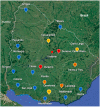Clinical and Epidemiological Characteristics of Sporotrichosis in a Reference Center of Uruguay
- PMID: 35330324
- PMCID: PMC8950135
- DOI: 10.3390/jof8030322
Clinical and Epidemiological Characteristics of Sporotrichosis in a Reference Center of Uruguay
Abstract
Background: Sporotrichosis is a fungal implantation disease of subacute/ chronic course caused by species of the dimorphic fungus Sporothrix spp. This infection usually develops after traumatic inoculation of contaminated soil, plants or organic material contaminated by Sporothrix spp. conidia into skin or mucosa. The objective of this work is to contribute to the knowledge of sporotrichosis in Uruguay by providing a report of a series of cases diagnosed in a reference center.
Methods: We conducted a retrospective, observational, descriptive and cross-sectional study of cases of sporotrichosis diagnosed in the last 38 years.
Results: In the period analyzed, 157 cases of sporotrichosis were diagnosed, 152 of those corresponded to male patients. The most frequent clinical presentation was nodular lymphatic in 120 patients. In relation to epidemiological antecedents, 128 patients had been scratched by armadillos during hunting.
Conclusions: Sporotrichosis in Uruguay is a sporadic disease with a clear seasonal pattern related to particular social practices, such as hunting armadillos. Related to this practice, the affectation is greater in males and in young adults.
Keywords: Sporothrix spp.; implantation mycosis; sporotrichosis.
Conflict of interest statement
The authors declare no conflict of interest.
Figures




References
-
- Rippon J.W. Tratado de Micología Médica. Mc Graw-Hill; Interamericana, Mexico: 1990.
-
- De Oliveira L.C., Almeida-Paes R., Pizzini C.V., Gutierrez-Galhardo M.C., Freitas D.F.S., Zancopé-Oliveira R.M. Diagnostic performance of mycologic and serologic methods in a cohort of patients with suspected sporotrichosis. Revista Iberoamericana de Micología. 2019;36:61–65. doi: 10.1016/j.riam.2018.09.002. - DOI - PubMed
LinkOut - more resources
Full Text Sources
Miscellaneous

